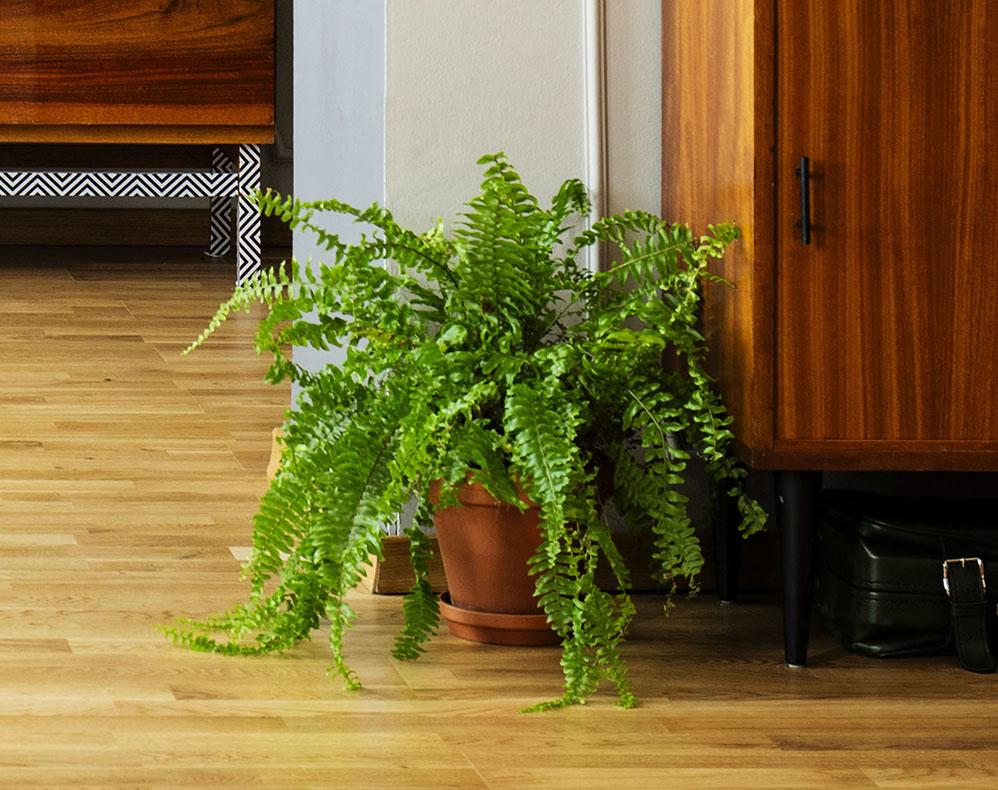When it comes to air pollution, we tend to think of carbon dioxide, ground-level ozone, and smog. But indoor air quality is just as important as the air outside. Inside your home, the air can be polluted from a variety of sources including: chemicals in household cleaners, furniture, and building materials.
Polluted indoor air can create host of potential health problems, from asthma to hormone disruption to cancer.
In 1989, NASA studied houseplants as a way to purify the air in space facilities. Their research uncovered several potted plants that filter out common volatile organic compounds (indoor air pollutants). Here are 20 plants that will help improve your home’s air quality.
1. Boston Fern
(Nephrolepis exaltata Bostoniensis)
The Boston fern is considered one of the most efficient air purifiers. Known for its ease of care, the fern has been a popular indoor plant since the Victorian era.
Plant Care
Boston ferns need a cool place with high humidity and indirect light. You’ll need to provide additional humidity for them, especially in the winter. Try setting your fern’s pot on a tray of pebbles filled with water, or lightly misting your fern once or twice a week. Fertilize once a month in the summer and once every two to three months in the winter in a water soluble mixed at half strength.
Pet Friendly? Yes
2. Areca Palm
(Chyrsalidocarpus lutescens)
Native to Madagascar, the areca palm—also known as the yellow butterfly palm, golden cane palm, or bamboo palm—is one of the easiest palm trees to grow indoors.
Plant Care
The areca palm needs filter light near a southeast or west-facing window. Moist, well-drained soil is recommended, and it’s best to water the plants as soon as the soil starts to feel dry below the surface. Fertilize with a time-release fertilizer in the spring.
Pet Friendly? Yes
3. The Lady Palm
(Rhapis excelsa)
The lady palm adapts to a wide range of climates, soils, and environments, making it a popular plant in homes around the world. Native to Asia, the evergreen perennial grows to a maximum height of six feet indoors.
Plant Care
Lady palm plants can tolerate low levels of light, high amounts of water, and varying temperatures. The plant thrives with moist soil, but remember that it needs proper drainage to avoid root rot. Lady palms are slow-growing plants and need very little fertilizer. As a guideline, apply only half the recommended required by other plants in your home.
Pet Friendly? Yes
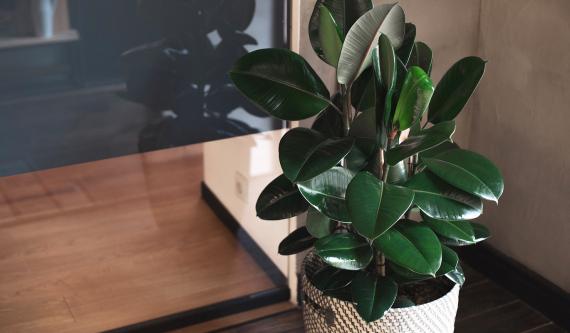
4. Rubber Plant
(Ficus robusta)
The benefit of the rubber plant is that it’s basically like growing a small tree indoors. The plant grows up to 10 feet in height and is easy to care for indoors.
Plant Care
The plant is easy to care for and can grow well in low light. It does best in a bright spot without direct sunlight. Water the soil when it becomes slightly dry and make sure the pot has sufficient drainage. Fertilize during spring and summer with a diluted liquid fertilizer every two weeks.
Pet Friendly? No.
5. Bamboo Palm
(Chamaedorea seifrizii)
The bamboo palm is easy to care for and adds warmth and color to you home with a mature height of 5-12 feet.
Plant Care
The bamboo plant prefers humidity, bright, indirect light, but doesn’t tolerate overwatering well. Remove brown leaves on a regular basis. Also watch for mites, especially on the underside of leaves. If you find mites, wash the leaves with a soapy water mixture. Fertilize using a granular, time-release fertilizer during the growing season.
Pet Friendly? Yes
6. Dracaena Janet Craig
(Dracaena deremensis)
The drancaena Janet Craig is a durable indoor plant that can handle a variety of conditions.
Plant Care
The plant is able to handle low humidity and air conditioning, and grows best in filtered sunlight. The plant does not tolerate excessive heat over 90 degrees. When watering, it’s better to keep the plant on the dry side, and try to avoid wet or dry extremes. Use of fertilizers can damage the plant and leave salts behind in the soil, so do not fertilize this plant unless you know you are using the correct type of fertilizer.
Pet Friendly? No.
7. English Ivy
(Hedera helix)
English ivy plants, also known as California or sweetheart ivy, are excellent climbers that can cling to almost any surface and are easy to maintain.
Plant Care
English ivy does best in bright light and prefers being kept on the dry side. English ivy is prone to fungal diseases, so be sure not to over-water. Apply fertilizer twice a year in early spring and midsummer.
Pet friendly? No.
8. Pygmy Date Palm
(Phoenix roebelenii)
The pygmy date palm is a slow growing ornamental pam that grows up to 4-6 feet in height.
Plant Care
The palm prefers bright light with a mixture of sun and shade. You can water them frequently during the spring and summer, and mist them if the room gets too humid. Make sure there are no cold drafts near your palm. Fertilize with a slow-release granular fertilizer every three months between April and September.
Pet Friendly? Yes
9. Ficus Alii
(Ficus macleilandii alii)
This evergreen makes a good houseplant as its roots grow slowly and minimizes the need to re-pot the plant. The plant grows up to 10 feet in height.
Plant Care
Native to Thailand, it enjoys bright, indirect light and to be watered thoroughly while being dried out in between. Use lukewarm water when watering because cold water may cause leaf loss, and avoid using softened water because it contains salts that can harm ficus plants. Slow-release, water soluble and liquid fertilizers work best for ficus trees, which should be fertilized once a month in the spring and summer.
Pet Friendly? No.
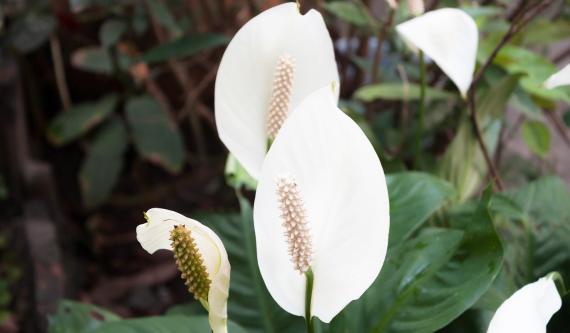
10. Peace Lily
(Spathiphyllum sp.)
Peace lilies are hardy plants known to be low maintenance. They are not true lilies but do flower with white blooms in the spring.
Plant Care
Peace lilies enjoy shade and some indirect light. Give it a good watering at once and then let it have a chance to dry out. Peace lilies only need to be fertilized once or twice a year.
Pet friendly? No
11. Corn Plant
(Dracaena fragrans Massangeana)
The corn plant can grow up to six feet tall and is perfect for a center piece in a room or a focal point.
Plant Care
The corn plant is a low maintenance, hardy houseplant. Avoid overwatering or using too much fertilizer, and keep it away from drafts and direct sun. Prune it back in the spring or early summer to control its growth. Fertilize monthly between spring and fall using a soluble fertilizer formulated for tropical plants.
Pet Friendly? No
12. Golden Pothos
(Epipremnum aureum)
The plant, also known as devil’s ivy, money plant, and silver vine, is characterized by its golden, heart-shaped leaves. The plant is considered an invasive species and is illegal to grow outdoors in some states.
Plant Care
The golden pothos does best in partial shade and only requires watering when the top quarter inch of soil feels dry to the touch. During the fall and winter, reduce watering to allow the top quarter inch of soil to fully dry out before watering more. Pothos plants can do well without fertilizer. If you wish to fertilize, feed it a half dose three or four times a year.
Pet Friendly? No
13. Kimberly Queen Fern
(Nephrolepis obliterata)
The Kimberly queen fern is more compact, tidier, and easier to care for than other ferns, and it’s well suited for an indoor environment.
Plant Care
A Kimberly queen thrives in bright, indirect light and can even survive in direct sun. Allow the top two or three inches of soil to dry out before watering, and remember that the fern needs high humidity to thrive. Fertilize monthly in the spring and summer, and every other month in the fall and winter.
Pet Friendly? Yes
14. Florist’s Mum
(Chrysanthemum morifolium)
The florist’s mum, also known as the pot mum or chrysanthemum, are normally outdoor plants and only grow temporarily inside the home for about 6-8 weeks. Popular for a Mother’s Day or holiday gift, the mum offers a bright splash of color at home.
Plant Care
Positioning the mum in bright light and watering it up to twice a week to keep the soil damp will help the plant thrive. Fertilize once a month only in the growing season.
Pet friendly? No
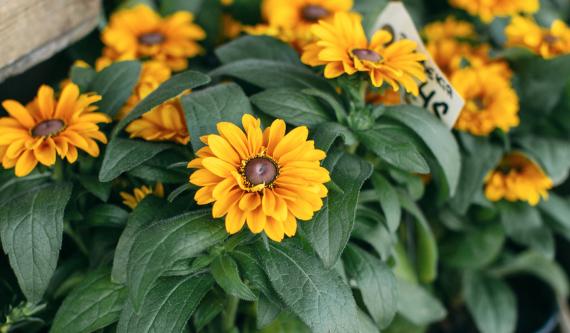
15. Gerbera Daisy
(Gerbera jamesonii) Gerbera daisies are known for long-lasting blooms, bright green foliage, and ease of care when grown outdoors. However, the daisies, also known as Transvaal daisies or gerber daisies, can be more challenging to maintain when grown inside.
Plant Care
Gerbera houseplants require both bright light and moderate temperatures. Too much sun might scorch the leaves, and the plant cannot tolerate temperatures above 70. Water the plant deeply when the top inch of soil feels dry to the touch, and keep the leaves as dry as possible. Also, the daisy should be watered minimally during the winter months, but make sure the soil doesn’t get too dry. Feed with a liquid fertilizer once a month or use slow-release fertilizers two to three times during the growing season.
Pet Friendly? No
16. Dracaena Warneckii
(Dracaena deremensis warneckei)
A dracaena Warneckii, which is a green dracaena cultivar with white strips along the edges of its leaves, is an undemanding plant.
Plant Care
Too much or too little water can brown the leaves on a Warneckii, and it’s recommended that you water it once per week. While you don’t need high humidity levels with this plant, a humidity level of less than 40 percent will brown the leaf tips and turn them brittle. Fertilize young plants twice monthly with a liquid fertilizer, and increase fertilization of older plants to once a week during the spring and summer.
Pet Friendly? No.
17. Madagascar Dragon Tree
(Dracaena marginata)
With slim leaves and the potential to grow up to 6 feet tall indoors, the Madagascar Dragon Tree is a beautiful addition to any home.
Plant Care
Light shade is recommended for the dragon tree, and keep the soil moist at all times. Cut back on watering in the winter but still make sure the soil doesn’t completely dry out. Fertilize once or twice a year at a minimum.
Pet Friendly? No
18. Schefflera
(Brassaia actinophylla)
Schefflera plants are popular because of their small size and ease of care. The most well-known schefflera plants are the umbrella tree and dwarf umbrella tree.
Plant Care
Schefflera plants thrive in plenty of light and an evenly moist environment. Water moderately during growth and keep only moist during the winter months. The plant does not need to be fertilized. If you do choose to fertilize it, do so with a half solution water soluble fertilizer once a year.
Pet Friendly? No
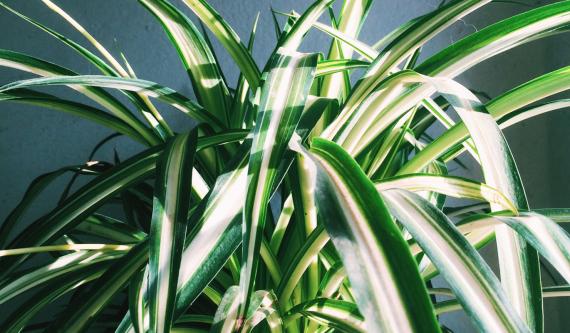
19. Spider Plant
(Chlorophytum comosum)
The spider plant is considered one of the most common household plants and easiest to grow.
Plant Care
The spider plants do best in well-drained soil and bright, indirect light. Water the plant well, but let it dry out a bit in between. These plants also benefit from some pruning, which you can do by cutting back to the base. Spider plants are very durable and can survive without fertilizer. If you do fertilize, do so once a month during the growing season with liquid fertilizer.
Pet Friendly? Yes
20. Weeping Fig
(Ficus benjamina)
The weeping fig is a slow growing plant that grows up to 10 feet tall.
Plant Care: Position the weeping fig in bright light and avoid moving the tree as it does not like change. Water with tepid filtered or distilled water, and plant it with a fast-draining soil-less mix. Fertilize once a month from April to September only.
Pet Friendly? No


